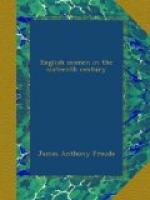The expedition sailed in October 1562. They called at the Canaries, where they were warmly entertained. They went on to Sierra Leone, where they collected 300 negroes. They avoided the Government factories, and picked them up as they could, some by force, some by negotiation with local chiefs, who were as ready to sell their subjects as Sancho Panza intended to be when he got his island. They crossed without misadventure to St. Domingo, where Hawkins represented that he was on a voyage of discovery; that he had been driven out of his course and wanted food and money. He said he had certain slaves with him, which he asked permission to sell. What he had heard at the Canaries turned out to be exactly true. So far as the Governor of St. Domingo knew, Spain and England were at peace. Privateers had not troubled the peace of the Caribbean Sea, or dangerous heretics menaced the Catholic faith there. Inquisitors might have been suspicious, but the Inquisition had not yet been established beyond the Atlantic. The Queen of England was his sovereign’s sister-in-law, and the Governor saw no reason why he should construe his general instructions too literally. The planters were eager to buy, and he did not wish to be unpopular. He allowed Hawkins to sell two out of his three hundred negroes, leaving the remaining hundred as a deposit should question be raised about the duty. Evidently the only doubt in the Governor’s mind was whether the Madrid authorities would charge foreign importers on a higher scale. The question was new. No stranger had as yet attempted to trade there.
Everyone was satisfied, except the negroes, who were not asked their opinion. The profits were enormous. A ship in the harbour was about to sail for Cadiz. Hawkins invested most of what he had made in a cargo of hides, for which, as he understood, there was a demand in Spain, and he sent them over in her in charge of one of his partners. The Governor gave him a testimonial for good conduct during his stay in the port, and with this and with his three vessels he returned leisurely to England, having, as he imagined, been splendidly successful.




